+ Open data
Open data
- Basic information
Basic information
| Entry | Database: PDB / ID: 7z8r | |||||||||
|---|---|---|---|---|---|---|---|---|---|---|
| Title | CAND1-CUL1-RBX1 | |||||||||
 Components Components |
| |||||||||
 Keywords Keywords |  LIGASE / cullin-RING E3 ubiquitin ligase / Assembly factor / CAND1 LIGASE / cullin-RING E3 ubiquitin ligase / Assembly factor / CAND1 | |||||||||
| Function / homology |  Function and homology information Function and homology information SCF complex assembly / Parkin-FBXW7-Cul1 ubiquitin ligase complex / negative regulation of catalytic activity / cullin-RING-type E3 NEDD8 transferase / cellular response to chemical stress / NEDD8 transferase activity / cullin-RING ubiquitin ligase complex / Cul7-RING ubiquitin ligase complex / ubiquitin-dependent protein catabolic process via the C-end degron rule pathway / Loss of Function of FBXW7 in Cancer and NOTCH1 Signaling ... SCF complex assembly / Parkin-FBXW7-Cul1 ubiquitin ligase complex / negative regulation of catalytic activity / cullin-RING-type E3 NEDD8 transferase / cellular response to chemical stress / NEDD8 transferase activity / cullin-RING ubiquitin ligase complex / Cul7-RING ubiquitin ligase complex / ubiquitin-dependent protein catabolic process via the C-end degron rule pathway / Loss of Function of FBXW7 in Cancer and NOTCH1 Signaling ... SCF complex assembly / Parkin-FBXW7-Cul1 ubiquitin ligase complex / negative regulation of catalytic activity / cullin-RING-type E3 NEDD8 transferase / cellular response to chemical stress / NEDD8 transferase activity / cullin-RING ubiquitin ligase complex / Cul7-RING ubiquitin ligase complex / ubiquitin-dependent protein catabolic process via the C-end degron rule pathway / Loss of Function of FBXW7 in Cancer and NOTCH1 Signaling / positive regulation of protein autoubiquitination / protein neddylation / NEDD8 ligase activity / Cul5-RING ubiquitin ligase complex / SCF-dependent proteasomal ubiquitin-dependent protein catabolic process / ubiquitin-ubiquitin ligase activity / Cul4A-RING E3 ubiquitin ligase complex / Cul2-RING ubiquitin ligase complex / SCF complex assembly / Parkin-FBXW7-Cul1 ubiquitin ligase complex / negative regulation of catalytic activity / cullin-RING-type E3 NEDD8 transferase / cellular response to chemical stress / NEDD8 transferase activity / cullin-RING ubiquitin ligase complex / Cul7-RING ubiquitin ligase complex / ubiquitin-dependent protein catabolic process via the C-end degron rule pathway / Loss of Function of FBXW7 in Cancer and NOTCH1 Signaling / positive regulation of protein autoubiquitination / protein neddylation / NEDD8 ligase activity / Cul5-RING ubiquitin ligase complex / SCF-dependent proteasomal ubiquitin-dependent protein catabolic process / ubiquitin-ubiquitin ligase activity / Cul4A-RING E3 ubiquitin ligase complex / Cul2-RING ubiquitin ligase complex /  SCF ubiquitin ligase complex / negative regulation of type I interferon production / Cul4B-RING E3 ubiquitin ligase complex / ubiquitin ligase complex scaffold activity / Cul3-RING ubiquitin ligase complex / Prolactin receptor signaling / protein monoubiquitination / cullin family protein binding / positive regulation of RNA polymerase II transcription preinitiation complex assembly / protein K48-linked ubiquitination / Nuclear events stimulated by ALK signaling in cancer / SCF ubiquitin ligase complex / negative regulation of type I interferon production / Cul4B-RING E3 ubiquitin ligase complex / ubiquitin ligase complex scaffold activity / Cul3-RING ubiquitin ligase complex / Prolactin receptor signaling / protein monoubiquitination / cullin family protein binding / positive regulation of RNA polymerase II transcription preinitiation complex assembly / protein K48-linked ubiquitination / Nuclear events stimulated by ALK signaling in cancer /  ubiquitin ligase complex / positive regulation of TORC1 signaling / TBP-class protein binding / ubiquitin ligase complex / positive regulation of TORC1 signaling / TBP-class protein binding /  Regulation of BACH1 activity / Regulation of BACH1 activity /  T cell activation / T cell activation /  post-translational protein modification / MAP3K8 (TPL2)-dependent MAPK1/3 activation / intrinsic apoptotic signaling pathway / SCF-beta-TrCP mediated degradation of Emi1 / NIK-->noncanonical NF-kB signaling / Degradation of DVL / Dectin-1 mediated noncanonical NF-kB signaling / Recognition of DNA damage by PCNA-containing replication complex / cellular response to amino acid stimulus / Degradation of GLI1 by the proteasome / Activation of NF-kappaB in B cells / Negative regulation of NOTCH4 signaling / animal organ morphogenesis / Iron uptake and transport / GSK3B and BTRC:CUL1-mediated-degradation of NFE2L2 / Vif-mediated degradation of APOBEC3G / Hedgehog 'on' state / G1/S transition of mitotic cell cycle / DNA Damage Recognition in GG-NER / Degradation of GLI2 by the proteasome / GLI3 is processed to GLI3R by the proteasome / FBXL7 down-regulates AURKA during mitotic entry and in early mitosis / RING-type E3 ubiquitin transferase / Degradation of beta-catenin by the destruction complex / Oxygen-dependent proline hydroxylation of Hypoxia-inducible Factor Alpha / negative regulation of canonical Wnt signaling pathway / Dual Incision in GG-NER / Transcription-Coupled Nucleotide Excision Repair (TC-NER) / NOTCH1 Intracellular Domain Regulates Transcription / Formation of TC-NER Pre-Incision Complex / CLEC7A (Dectin-1) signaling / SCF(Skp2)-mediated degradation of p27/p21 / Constitutive Signaling by NOTCH1 PEST Domain Mutants / Constitutive Signaling by NOTCH1 HD+PEST Domain Mutants / Regulation of expression of SLITs and ROBOs / Formation of Incision Complex in GG-NER / FCERI mediated NF-kB activation / Interleukin-1 signaling / protein polyubiquitination / Orc1 removal from chromatin / Dual incision in TC-NER / Gap-filling DNA repair synthesis and ligation in TC-NER / Regulation of RAS by GAPs / positive regulation of protein catabolic process / Regulation of RUNX2 expression and activity / cellular response to UV / Cyclin D associated events in G1 / post-translational protein modification / MAP3K8 (TPL2)-dependent MAPK1/3 activation / intrinsic apoptotic signaling pathway / SCF-beta-TrCP mediated degradation of Emi1 / NIK-->noncanonical NF-kB signaling / Degradation of DVL / Dectin-1 mediated noncanonical NF-kB signaling / Recognition of DNA damage by PCNA-containing replication complex / cellular response to amino acid stimulus / Degradation of GLI1 by the proteasome / Activation of NF-kappaB in B cells / Negative regulation of NOTCH4 signaling / animal organ morphogenesis / Iron uptake and transport / GSK3B and BTRC:CUL1-mediated-degradation of NFE2L2 / Vif-mediated degradation of APOBEC3G / Hedgehog 'on' state / G1/S transition of mitotic cell cycle / DNA Damage Recognition in GG-NER / Degradation of GLI2 by the proteasome / GLI3 is processed to GLI3R by the proteasome / FBXL7 down-regulates AURKA during mitotic entry and in early mitosis / RING-type E3 ubiquitin transferase / Degradation of beta-catenin by the destruction complex / Oxygen-dependent proline hydroxylation of Hypoxia-inducible Factor Alpha / negative regulation of canonical Wnt signaling pathway / Dual Incision in GG-NER / Transcription-Coupled Nucleotide Excision Repair (TC-NER) / NOTCH1 Intracellular Domain Regulates Transcription / Formation of TC-NER Pre-Incision Complex / CLEC7A (Dectin-1) signaling / SCF(Skp2)-mediated degradation of p27/p21 / Constitutive Signaling by NOTCH1 PEST Domain Mutants / Constitutive Signaling by NOTCH1 HD+PEST Domain Mutants / Regulation of expression of SLITs and ROBOs / Formation of Incision Complex in GG-NER / FCERI mediated NF-kB activation / Interleukin-1 signaling / protein polyubiquitination / Orc1 removal from chromatin / Dual incision in TC-NER / Gap-filling DNA repair synthesis and ligation in TC-NER / Regulation of RAS by GAPs / positive regulation of protein catabolic process / Regulation of RUNX2 expression and activity / cellular response to UV / Cyclin D associated events in G1 /  ubiquitin protein ligase activity / KEAP1-NFE2L2 pathway / ubiquitin protein ligase activity / KEAP1-NFE2L2 pathway /  Regulation of PLK1 Activity at G2/M Transition / Regulation of PLK1 Activity at G2/M Transition /  MAPK cascade / protein-macromolecule adaptor activity / positive regulation of proteasomal ubiquitin-dependent protein catabolic process / Antigen processing: Ubiquitination & Proteasome degradation / MAPK cascade / protein-macromolecule adaptor activity / positive regulation of proteasomal ubiquitin-dependent protein catabolic process / Antigen processing: Ubiquitination & Proteasome degradation /  Circadian Clock / Downstream TCR signaling / Circadian Clock / Downstream TCR signaling /  Neddylation / ubiquitin-dependent protein catabolic process / Neddylation / ubiquitin-dependent protein catabolic process /  spermatogenesis / proteasome-mediated ubiquitin-dependent protein catabolic process / secretory granule lumen / positive regulation of canonical NF-kappaB signal transduction / cell population proliferation / ficolin-1-rich granule lumen / RNA polymerase II-specific DNA-binding transcription factor binding / Potential therapeutics for SARS spermatogenesis / proteasome-mediated ubiquitin-dependent protein catabolic process / secretory granule lumen / positive regulation of canonical NF-kappaB signal transduction / cell population proliferation / ficolin-1-rich granule lumen / RNA polymerase II-specific DNA-binding transcription factor binding / Potential therapeutics for SARSSimilarity search - Function | |||||||||
| Biological species |   Homo sapiens (human) Homo sapiens (human) | |||||||||
| Method |  ELECTRON MICROSCOPY / ELECTRON MICROSCOPY /  single particle reconstruction / single particle reconstruction /  cryo EM / Resolution: 2.7 Å cryo EM / Resolution: 2.7 Å | |||||||||
 Authors Authors | Baek, K. / Schulman, B.A. | |||||||||
| Funding support |  Germany, European Union, 2items Germany, European Union, 2items
| |||||||||
 Citation Citation |  Journal: Cell / Year: 2023 Journal: Cell / Year: 2023Title: Systemwide disassembly and assembly of SCF ubiquitin ligase complexes. Authors: Kheewoong Baek / Daniel C Scott / Lukas T Henneberg / Moeko T King / Matthias Mann / Brenda A Schulman /   Abstract: Cells respond to environmental cues by remodeling their inventories of multiprotein complexes. Cellular repertoires of SCF (SKP1-CUL1-F box protein) ubiquitin ligase complexes, which mediate much ...Cells respond to environmental cues by remodeling their inventories of multiprotein complexes. Cellular repertoires of SCF (SKP1-CUL1-F box protein) ubiquitin ligase complexes, which mediate much protein degradation, require CAND1 to distribute the limiting CUL1 subunit across the family of ∼70 different F box proteins. Yet, how a single factor coordinately assembles numerous distinct multiprotein complexes remains unknown. We obtained cryo-EM structures of CAND1-bound SCF complexes in multiple states and correlated mutational effects on structures, biochemistry, and cellular assays. The data suggest that CAND1 clasps idling catalytic domains of an inactive SCF, rolls around, and allosterically rocks and destabilizes the SCF. New SCF production proceeds in reverse, through SKP1-F box allosterically destabilizing CAND1. The CAND1-SCF conformational ensemble recycles CUL1 from inactive complexes, fueling mixing and matching of SCF parts for E3 activation in response to substrate availability. Our data reveal biogenesis of a predominant family of E3 ligases, and the molecular basis for systemwide multiprotein complex assembly. | |||||||||
| History |
|
- Structure visualization
Structure visualization
| Structure viewer | Molecule:  Molmil Molmil Jmol/JSmol Jmol/JSmol |
|---|
- Downloads & links
Downloads & links
- Download
Download
| PDBx/mmCIF format |  7z8r.cif.gz 7z8r.cif.gz | 345.4 KB | Display |  PDBx/mmCIF format PDBx/mmCIF format |
|---|---|---|---|---|
| PDB format |  pdb7z8r.ent.gz pdb7z8r.ent.gz | 271.7 KB | Display |  PDB format PDB format |
| PDBx/mmJSON format |  7z8r.json.gz 7z8r.json.gz | Tree view |  PDBx/mmJSON format PDBx/mmJSON format | |
| Others |  Other downloads Other downloads |
-Validation report
| Arichive directory |  https://data.pdbj.org/pub/pdb/validation_reports/z8/7z8r https://data.pdbj.org/pub/pdb/validation_reports/z8/7z8r ftp://data.pdbj.org/pub/pdb/validation_reports/z8/7z8r ftp://data.pdbj.org/pub/pdb/validation_reports/z8/7z8r | HTTPS FTP |
|---|
-Related structure data
| Related structure data |  14561MC 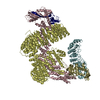 7z8tC 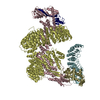 7z8vC  7zbwC  7zbzC 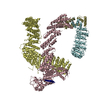 8cdjC 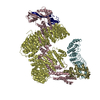 8cdkC M: map data used to model this data C: citing same article ( |
|---|---|
| Similar structure data | Similarity search - Function & homology  F&H Search F&H Search |
- Links
Links
- Assembly
Assembly
| Deposited unit | 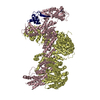
|
|---|---|
| 1 |
|
- Components
Components
| #1: Protein |  / CUL-1 / CUL-1Mass: 89800.367 Da / Num. of mol.: 1 Source method: isolated from a genetically manipulated source Source: (gene. exp.)   Homo sapiens (human) / Gene: CUL1 / Production host: Homo sapiens (human) / Gene: CUL1 / Production host:   Trichoplusia ni (cabbage looper) / References: UniProt: Q13616 Trichoplusia ni (cabbage looper) / References: UniProt: Q13616 | ||
|---|---|---|---|
| #2: Protein | Mass: 137386.281 Da / Num. of mol.: 1 Source method: isolated from a genetically manipulated source Source: (gene. exp.)   Homo sapiens (human) / Gene: CAND1, KIAA0829, TIP120, TIP120A / Production host: Homo sapiens (human) / Gene: CAND1, KIAA0829, TIP120, TIP120A / Production host:   Escherichia coli BL21(DE3) (bacteria) / References: UniProt: Q86VP6 Escherichia coli BL21(DE3) (bacteria) / References: UniProt: Q86VP6 | ||
| #3: Protein | Mass: 12089.677 Da / Num. of mol.: 1 Source method: isolated from a genetically manipulated source Source: (gene. exp.)   Homo sapiens (human) / Gene: RBX1, RNF75, ROC1 / Production host: Homo sapiens (human) / Gene: RBX1, RNF75, ROC1 / Production host:   Trichoplusia ni (cabbage looper) / References: UniProt: P62877 Trichoplusia ni (cabbage looper) / References: UniProt: P62877 | ||
| #4: Chemical | | Has ligand of interest | Y | |
-Experimental details
-Experiment
| Experiment | Method:  ELECTRON MICROSCOPY ELECTRON MICROSCOPY |
|---|---|
| EM experiment | Aggregation state: PARTICLE / 3D reconstruction method:  single particle reconstruction single particle reconstruction |
- Sample preparation
Sample preparation
| Component | Name: CAND1-CUL1-RBX1 / Type: COMPLEX / Entity ID: #1-#3 / Source: RECOMBINANT |
|---|---|
| Source (natural) | Organism:   Homo sapiens (human) Homo sapiens (human) |
| Source (recombinant) | Organism:   Escherichia coli (E. coli) Escherichia coli (E. coli) |
| Buffer solution | pH: 7.5 |
| Specimen | Conc.: 2 mg/ml / Embedding applied: NO / Shadowing applied: NO / Staining applied : NO / Vitrification applied : NO / Vitrification applied : YES : YES |
Vitrification | Cryogen name: ETHANE |
- Electron microscopy imaging
Electron microscopy imaging
| Experimental equipment |  Model: Titan Krios / Image courtesy: FEI Company |
|---|---|
| Microscopy | Model: FEI TITAN KRIOS |
| Electron gun | Electron source : :  FIELD EMISSION GUN / Accelerating voltage: 300 kV / Illumination mode: FLOOD BEAM FIELD EMISSION GUN / Accelerating voltage: 300 kV / Illumination mode: FLOOD BEAM |
| Electron lens | Mode: BRIGHT FIELD Bright-field microscopy / Nominal defocus max: 2000 nm / Nominal defocus min: 500 nm Bright-field microscopy / Nominal defocus max: 2000 nm / Nominal defocus min: 500 nm |
| Image recording | Electron dose: 60 e/Å2 / Film or detector model: GATAN K3 BIOQUANTUM (6k x 4k) |
- Processing
Processing
| Software | Name: PHENIX / Version: 1.19.2_4158: / Classification: refinement | ||||||||||||||||||||||||
|---|---|---|---|---|---|---|---|---|---|---|---|---|---|---|---|---|---|---|---|---|---|---|---|---|---|
CTF correction | Type: PHASE FLIPPING AND AMPLITUDE CORRECTION | ||||||||||||||||||||||||
3D reconstruction | Resolution: 2.7 Å / Resolution method: FSC 0.143 CUT-OFF / Num. of particles: 351565 / Symmetry type: POINT | ||||||||||||||||||||||||
| Refine LS restraints |
|
 Movie
Movie Controller
Controller

















































 PDBj
PDBj








